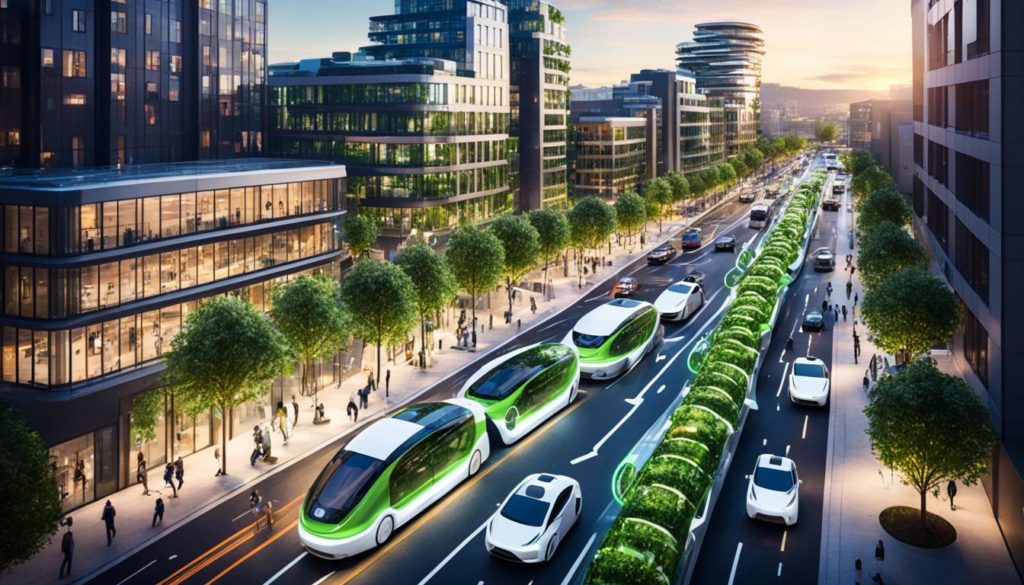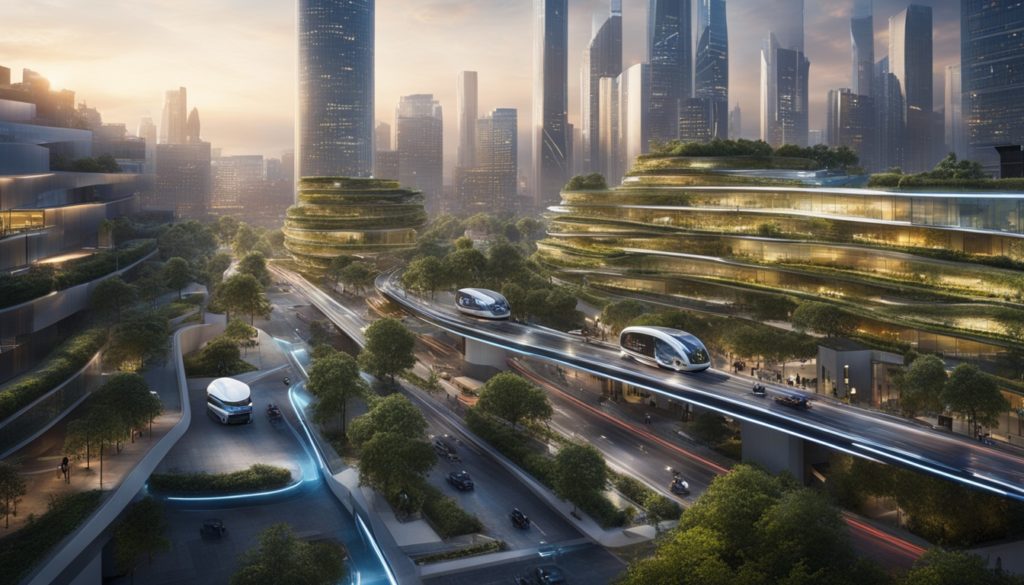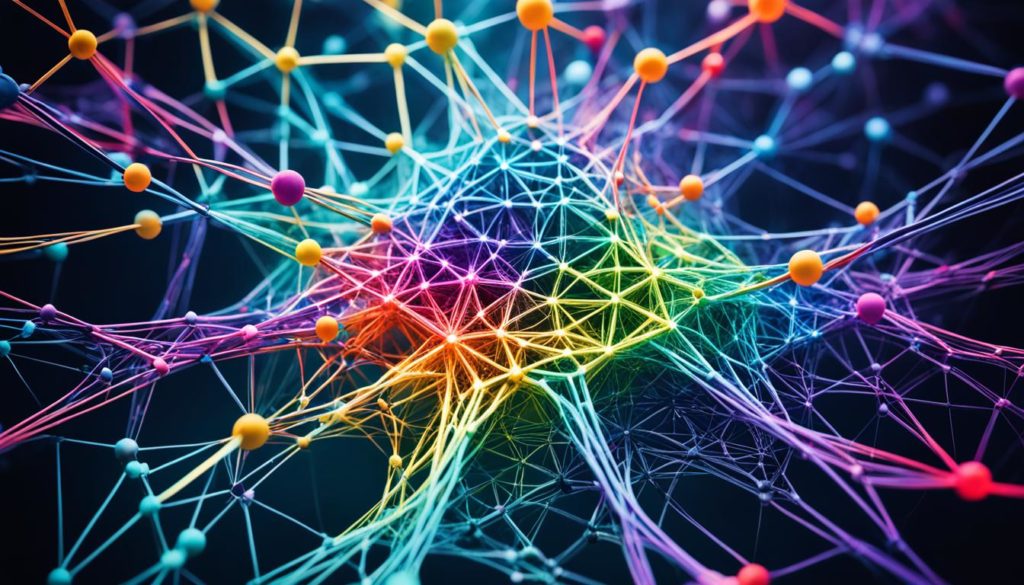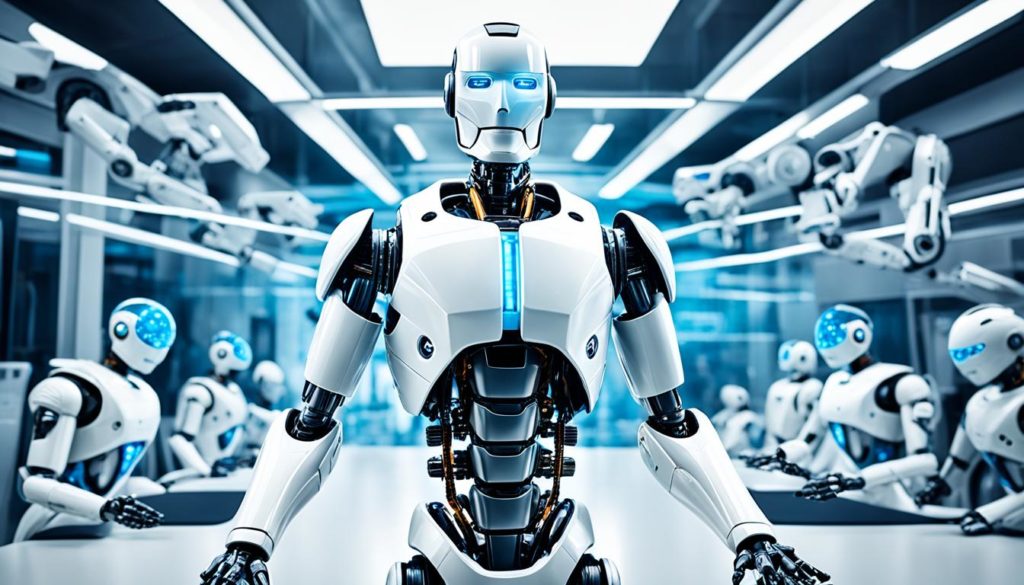
Did you know that by 2050, it’s believed 68% of people will live in cities? This huge move to cities means we need to find sustainable ways to live. Smart cities are the answer, blending tech and innovation to build places that care about sustainability, efficiency, and making life better for their people.
Nowadays, connection and community are key, and smart cities reflect this change. They use top-notch tech and data to not just improve what’s around us but to also build strong communities. Through things like parks and smarter ways to govern, smart cities tackle the unique challenges they face, always putting people first.
Exploring the future of smart cities shows us how they can tailor smart solutions to fit their special needs. This helps us move towards cities that are more livable, can bounce back, and welcome everyone. Are you ready to see the cutting-edge trends that will reshape our cities? Let’s start!
Key Takeaways
- 68% of the world’s population is expected to live in urban areas by 2050.
- Smart cities leverage technology and data analytics to drive sustainable urban development.
- Key trends include green public spaces and citizen-focused design.
- Smart cities prioritize community connections and inclusivity.
- Data-driven governance helps address unique urban challenges.
Introduction to Smart Cities
Smart cities are changing urban planning with new technology and data. They use the Internet of Things (IoT) to make cities efficient, sustainable, and better for living. With IoT, city operations become smoother and improve life through smart initiatives.
Defining Smart Cities
Smart cities use IoT, AI, and cloud computing to manage resources wisely. For example, data-driven cities analyze data for smart decisions. IoT devices give real-time insights for better management and services. This technology makes cities responsive and adaptable.
Significance of Smart Cities in Urban Development
Smart cities play a big role in today’s urban development. They meet growing population needs with innovative solutions. Through initiatives like smart infrastructure, cities handle resources well and save costs. Digital tools improve both infrastructure and life quality.
Smart cities also help the environment. By using resources wisely, they reduce energy use and fight climate change. Cities like London, Paris, and New York lead by using AI and IoT to make urban life sustainable. Such cities set examples for others to follow.
Learn more about the future of urban living and smart cities. See how technology changes our approach to urban management.
| City | Ranking | Major Initiative |
|---|---|---|
| London | 1st | Investing in AI, IoT, and 6G solutions |
| New York | 2nd | Sustainability and climate adaptation projects |
| Paris | 3rd | Paris Respire to reduce carbon footprint |
Key Components of Smart Cities
Smart city technologies are changing our lives. They make where we live, work, and play better. These technologies connect to create safe, efficient, and green cities.
Intelligent Infrastructure
At the heart of smart cities is intelligent infrastructure. IoT sensors and automation boost city efficiency and connectivity. For example, over 800,000 buildings in New York City use smart water meters. This allows real-time checks on water use and alerts about leaks. Singapore connects most of its homes and businesses to high-speed broadband. These steps make better use of resources and city management.
Data-Driven Governance
Effective management of cities relies on data-driven governance. Analytics provides real-time monitoring and helps make better decisions. New York is working to cut greenhouse gases by 40% in big buildings by 2030. It’s using data to guide this goal. Helsinki offers a great example of this. It shares over 3000 datasets on an open platform. This improves resource management and safety.
For how cities can govern more efficiently, see Developing Smart Cities.
Citizen Engagement and Empowerment
Engaging and empowering citizens is crucial in smart cities. Digital tools help people get involved in city planning and policies. Madrid lets people decide how to spend some of the budget. Singapore helps travelers with real-time information through its Smart Mobility 2030. These efforts not only give people a voice but also bring them together.
To see how tech boosts citizen involvement, visit Smart Cities of the Future.
Cities are becoming smarter by using tech, data, and involving everyone. This move to digital makes cities safer, more efficient, and eco-friendly for all.
| City | Key Initiative | Impact |
|---|---|---|
| New York | Smart Water Meters | Real-time tracking of water usage |
| Singapore | High-speed Broadband | 95% connectivity of homes and businesses |
| Helsinki | Open Data Platform | Over 3000 datasets available |
| Madrid | Participatory Budgeting | Citizen allocation of funds |
Future of Smart Cities
The future of smart cities is shaping up to be exciting. They will grow with technology and keep our planet in mind. These cities will link everything together, use data to plan better, and make getting around green and efficient.
In Pittsburgh, AI is helping manage traffic. This reduced travel time by 26% and cut down vehicle emissions by 21% at 50 intersections. Such advancements show how smart tech can greatly affect our cities.
The next big steps include using more renewable energy, better waste handling, and adding more green spaces. Barcelona’s smart systems are saving money and creating jobs. These efforts make urban life more sustainable.
Smart cities will also test new tech like driverless cars and smart utilities. The IoT is key, helping understand and improve how cities work. For example, Amsterdam is using IoT to boost traffic flow, energy efficiency, and safety.
With more people living in cities, the push for smart, sustainable planning is urgent. Currently, half the world lives in cities. This could hit 75% soon. We will need smart solutions for housing and infrastructure for 3 billion more people.
For more on smart city advancements, check this out.
Looking forward, improving waste management, energy saving in buildings, and green working conditions are key. Smart technologies will not only make cities work better but also improve life for everyone. Take a look at this insight into the future.
Current Trends in Smart Cities
Smart cities are improving urban life with green plans, digital involvement, and smart travel options. The 15-Minute City idea is a big deal. It means key services are always close to people. This makes neighborhoods bond and city life better and easier.
Green Planning of Public Spaces
Green urban plans are now a big focus. Freetown wants 50% more green cover. Singapore leads in urban greenery, says MIT’s Senseable City Lab. Projects like mass transit and bike paths cut city carbon emissions by 15%.
Smart Health Communities
Digital solutions are changing public health services. Startups like eAgora get people involved in local decisions. Cities are using tech to focus on keeping people healthy before they get sick. This approach tackles behaviors causing many global deaths.
15-Minute City Concept
The 15-Minute City makes life better by having essentials close by. It fights urban sprawl and creates tighter communities. Cities become more walkable and liveable with this idea.
Mobility: Intelligent, Sustainable and as-a-Service
Transportation is turning smart. Car-sharing is now worth $8 billion and growing. EV charging networks are expanding with government support. Companies like BluSmart in India are seen as key in reducing CO2 emissions through shared rides.
Inclusive Services and Planning
Inclusivity is key in urban planning now. Shared data tools help public agencies work together. Companies like Automotus and Verra Mobility are working on new solutions. Inclusive approaches make sure everyone benefits from a city’s digital progress.
Check out more on smart city trends for more details. Also, see what’s next in urban living in Deloitte’s report and smart mobility predictions.
FAQ
What are the main trends shaping the future of smart cities?
The future of smart cities focuses on eco-friendly growth, innovation, and advanced technology. These trends include making more green spaces, planning services for everyone, and using data to guide city decisions. Also, putting IoT to work in city designs is key.
What defines a smart city?
A smart city uses new technology and data to make life better, more sustainable, and efficient. It brings together IoT, clever structures, and analysis of data. This way, city living adapts and improves quickly.
Why are smart cities significant in urban development?
Smart cities target the issues that come with growing city populations using sustainable and innovative steps. They use new infrastructure, collect and apply data, and embrace technology. This boosts governance, enhances living standards, and supports eco-friendly urban expansion.
What are the key components of smart cities?
The foundations of smart cities are advanced infrastructure, data-led decision-making, and involving citizens. Technologies and the digital makeover in cities help these elements function well.
How does intelligent infrastructure contribute to a smart city?
Intelligent infrastructure connects and improves different city sectors like energy and water systems. Thanks to IoT, automation, and data study, cities use resources wisely. This makes urban services better and cities more sturdy and smart.
What is data-driven governance?
Data-driven governance uses lots of data sources to keep an eye on and steer city environments. With data analysis and tech, cities make smart choices, plan better, and boost services. This leads to a more effective and responsive city environment.
How does citizen engagement and empowerment play a role in smart cities?
In smart cities, involving residents is key. They get a say in planning and upgrading city life. Digital methods help people take part in making policies and improving services. This makes sure the city develops with the people in mind and includes everyone.
What does the future hold for smart cities?
Smart cities are moving towards more technology, eco-friendly growth, and better-connected systems. Future cities will see things like predictive planning, new ways to move around, and designs focused on people. This will make city life better, greener, and more enjoyable.
What are the current trends in smart city development?
Today, smart cities aim for green spaces, health-focused communities, and the 15-minute city idea. They also push for smart and eco-friendly travel, and planning services that think of everyone. These approaches aim to mix efficiency with caring for the environment and community happiness.
How is green urban planning integrated into smart cities?
In smart cities, green planning means adding public green spaces and eco-friendly designs. It also involves adopting sustainable development practices. This doesn’t just help the planet but also makes cities nicer and healthier places to live.
What is the 15-Minute City concept?
The 15-Minute City idea means having what you need close to home. It promotes closer communities and easier access to services. This idea supports eco-friendly growth, cuts down travel time, and makes neighborhoods better places to live.
How is mobility evolving in smart cities?
Mobility in smart cities is turning to smarter, greener, and service-based ways. It includes clean transportation options and putting together mobility services. This lessens the need for private cars, making cities more efficient and less polluted.
What role does technology play in creating smart health communities?
Technology is a big part of building smart health communities. It brings digital tools into public health, focusing on preventing illness, keeping an eye on health, and easy access to health care. This makes the public healthier in city settings.
How are inclusive services and planning integrated into smart cities?
Smart cities aim to be welcoming to everyone. They use data to understand what different communities need, make sure everyone can access services, and design these services to help everyone. This approach builds a united and supportive community.
Future App Studios is an award-winning software development & outsourcing company. Our team of experts is ready to craft the solution your company needs.










